An Excellent How to by William Tyler
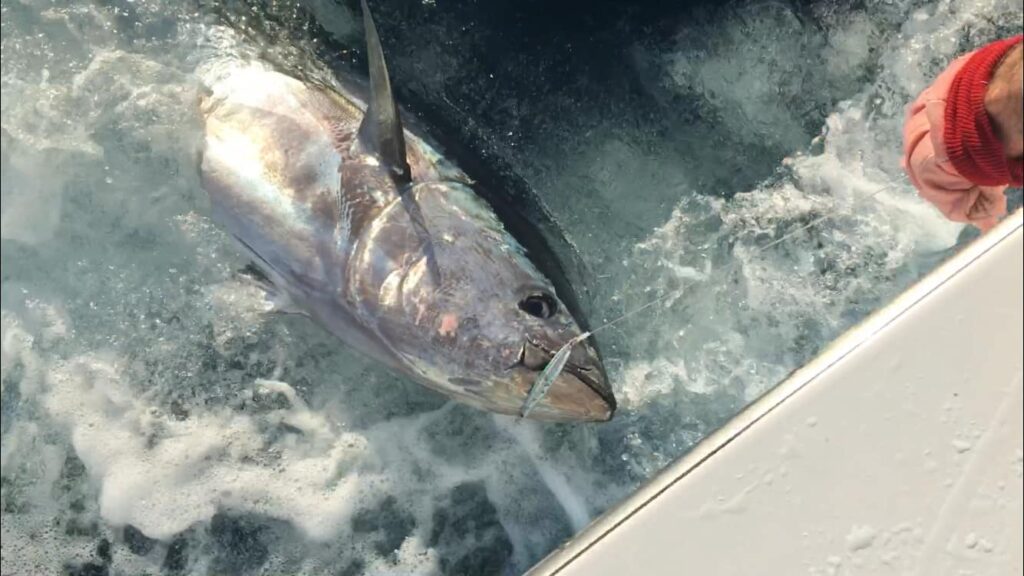
Introduction
There is a recreational fishery on the East Coast and it is like no other in the world. Imagine catching 10 to 20 fish in one day ranging from 300 to 800 pounds and being able to keep one. The press has been labeling this fishery as strictly catch and release, but if you follow the guidelines set by NMFS, you can keep one of these giants per year for your freezer and friends.
History
Giant bluefin had been occasionally caught off NC sporadically for the past 30 years. Several years ago there was an incident that hit the news about a recreational fishermen who caught a giant off Hatteras and had to let it rot because he did not have the correct permits from NMFS. In 1992, a head boat captain had his 4 aught reels stripped in December at a wreck. Curious as to what it was, he told a charter captain who was a friend. In February the, the captain went out and caught the first giant bluefins and recognized the significance. There is a now a growing charter industry that fishes for them from December to the beginning of April. No one is certain as to whether the fish have always been at the wrecks off Hatteras in winter or is this is a new migration pattern.
Rigging your Boat
So now you are legal. But what about your equipment. For a boat you need at least 20 feet, preferable 25 or greater. To fish Hatteras in the winter you must abide by the two engine rule. Either have two engines on your boat, or fish with a buddy. You may be able to break this rule on a flat, hot, sunny, populated, mid March, Sunday but be prepared to wait a few years. You need to realize that the weather off Hatteras is unpredictable and that the area has a low population. You have to have a reliable boat capable of canyon runs and one that is dependable.
Rods
The current thought has been that you need a fighting chair and Penn International 130 with a bent-butt fishing rod as thick as a broom stick, 130 lb mono and the drag set at 70 lbs. I spent 1800 dollars for a rig just like this, and then promptly found out that on a small boat, this is the wrong way to go. On a huge sixty foot sportfisher with a 3,000 dollar fighting chair that has a foot rest and a bucket harness, you have enough leverage to handle that type of rod. But on a small boat with stand up harness or a cheap folding chair, you are gonna get dragged right out of the boat to bottom by one of these fish.
The first fish we hooked was on my big rod. I quickly found out that I was over matched and we stuck the rod in the rod holder where the gel coat cracked and the rod nearly ripped up my boat. It took three of us in a scene reminiscent of the Iwo Jima flag raising to lift that rod from the bad rod holder and put it in another. The physics are that if you try to lift a 10 lb weight on a string tied to the tip of broom stick, you are going to have a tough time. But if you tie the string closer to your hands, you will find it easier to lift the weight. So a short standup rod that is rated for a limp 50 to 100 lbs test will bend alot, but will give you the edge in leverage. This will allow you to fight the fish stand-up. The only deficit is that the line is held closer to the boat, so you need to specially train your lineman to watch the line and guide it around your engines. This will happen a few times in the fight anyway, so a trained lineman will stop the fish from cutting your line on the only sharp object within a mile of your boat: your engines.
Catch and release Ethic
There is much controversy as to whether the fish are actually harmed. Because most people have already caught their one incidental permit fish, they are catch-and-releasing up to 20 fish a day. The commercial fishermen from up north don’t like this new catch-and-release fishery in “their” fishery and are claiming hat it kills the fish. The charter boats out of Hatteras claim it doesn’t hurt them at all.
I am of the opinion that you can hurt them if you use the wrong equipment. If you use a rod that is too small with wimpy line, you will have a long fight and the fish might go belly up when you finally get him along side of the boat. If you use 130 lb test with the drag set at 50 to 70 lbs, you bring them in “green” and the fish rockets away from the boat when you cut them lose. So the heavy tackle is good for the fish but makes it damn tough to fight stand-up. That is why I recommend the heavy-line-wimpy-rod theory. It makes it possible to stand up and fight the fish AND you get to release the fish “green”. But it does make the fight a heavy weight affair for big strong fellows. No wimps allowed.
Reels
After the disaster with the big rod, I had rigged a smaller rod as a back up. this turned out to be the best set up. I had a Tiagra 50 W with 130 lb dacron and 200 ft of 200 lb wind-on leader. The smaller rod is much light and easier to handle. The rod gives less leverage, yet I fought the fish just as hard because I had set my drag at the same pressure as on the big reel. You absolutely must use a scale to set your drag. You simple cannot set the drag at this level by feel. Because the drag has to be set a 75 lbs for full drag, you have to have a 100 lb hand scale. I found the Murry Brothers (1-800-845-3474) has a scale for 30 bucks that works fine. On my Tiagra, I set the strike stetting at 50 lbs, and the full setting should be at about 75 lbs. I rigged up my 50 SW and found that the drag setting could be set for similar amounts. But both these reels are not designed to have the drag set this high. There is still 10 lbs drag when you put them in free spool, so pulling out line is a real pain. Also, the levers are quite stiff to push. I also found that a two speed is really desirable. You can get along with the standard 50 TW, but I feel it is worth buying a SW for you reel collection for this fish. The low gear will drop your fighting time from 1 hour to 1/2 hour. This will help save the fishes life when you are releasing them. The less fight time, more chance of survivability for the fish.
Line
The big secret in using these smaller rods and reels is the line. I use 130 lb dacron with wind on leader. This works great because you get the hook setting no-stretch of dacron, and just enough shock absorbing stretch from the longer than normal leader. I use 200 feet of Momoi 200 lbs test leader because the diameter is less than normal leader diameter.
Leader
The wind-on connection is simple to make. Hold sand paper in your right hand and pull the last two feet of the leader through your hand to roughen up the surface. Use a razor to round the tip. Thread the 200 lbs mono into the inside of the dacron. You have to inchworm it on there for about two and a half feet. Get a pen of liquid superglue, mash the superglue pintip down on a metal surface to form a puddle and roll the line in it. Do this every inch. The end of the dacron fuzzes up, roll this in the super glue then trim with the razor against your thumbnail. This will allow you wind all the leader on the reel and get the fish close to the boat. This helps when you don’t have an experienced lineman and it is much safer.
Other equipment on Board
You will need a few other thing big game specialty items on board when dealing with fish this size. You need a 12 inch diameter flying gaff with a seven foot handle with twenty feet of half inch rope. I also have another 15 foot section of rope with a quick clip on the end and a bowline loop on the other to tie the rod and reel to a cleat. You die if you are in standup gear and one of these big fish drags you overboard. This is a must. You will also need a come-along hand winch to get the fish in the boat. Pulleys are a pain to deal with on a boat, come-alongs will drag a 1,000 lber in the boat with one person.
Weather
There general rule is that you cannot pick a Saturday and go because it will be rough, So, you and your fishing buddies need pick a two week stretch from February to April 1st, and wait. Watch the weather for a big stationary, slow moving High pressure system with real wide isobars. The telephone number for Hatteras weather is 1-800-697-7374. If you can stay on the phone, you can ask the weatherman for his opinion as to when the bast day is to go and they will tell you. If you are already down there and you want to save them the 800 charge, you can dial the local number at 223-5737. You can also dial the NOAH nationwide broadcast at 1-900-884-6622 and get the forcast for the 919 area code, but they charge a buck a minute for this service.
If you haven’t figured it out, he weather is the big problem with this fishery. In the summer, you get to go out nine out of ten days. In the winter, its one out of every ten and that day is often 6 feet seas. So the secret is to prepare your equipment and boat and wait. Do not go on marginal days. Wait for a guaranteed 3 day flat stretch. There is maybe one of these stretches in January or February, maybe two in March. Call the Red Drum Tackle Store 252-995-5414 and ask them if the giants are biting and how is the weather. This is where you can buy anything fishing tackle related when you are in Hatteras. Some people try the first time and the weather gets bad, so they leave their boat at Teaches Lair Marina (888) 868-2460 on the trailer and then go home and wait for the weather. Boat crime is non-existent in this little town.
Diamond shoals is the light tower off Hatteras and the wind there rarely drops less then 10. If you ever hear it is less than 10 at Diamond Shoals, then get in your car.
Cold and Engines
When you start your boat you may have cold weather trouble. I had checked the boat out the week before in 40 degrees and everything worked perfectly. But fist day I tried for bluefin, I was skunked because the day was a 25 degrees February day and a lot of things broke in the cold temperature. My starboard engine would not get full throttle because the temp gauge for the left cylinder bank malfunctioned and started cutting off the ignition for half the cylinders at 3,000 RPM. Then its shift cable got stuck so it would not go in reverse either. Then the port engine got stuck in full throttle because the butterfly choke valve froze in the open position. All of these things were temperature related malfunctions that happened all at once. Luckily, there is a great mechanic about half a mile from Teaches lair at Willis Boat Landing (252) 986-2208. There is also a NAPA in the town of Buxton which is about 8 miles north of Hatteras. The point I’m trying to make is that your boat will have a very high chance of malfunctioning in the cold and to take tools, WD-40 and have a mechanics number.
Hotel
When you get the green light for weather, call the Comfort Inn in Buxton (1-252-995-6100) and reserve a room. The Red Drum is right next door and you are about 8 miles form Teaches Lair.
Leaving the inlet
Put your boat in at Teaches Lair (888) 868-2460 , pay the 7 dollar ramp fee and buy a Hatteras map. They have the wreck numbers on the map. The inlet out of Teaches Lair is tricky. The best method is to follow someone out. You have a small channel that runs between the Teaches Lair and the Ocracoke Ferry channel . Then you simply follow ferry channel out 200 yards from the shore and then turn left for 2 miles to parallel the coast to the Hatteras inlet.
Where to go
The fish typical bite at the wrecks at the shelf drop off. The heading is nearly 180 degrees south. You will go about 25 miles south from the inlet. The Proteus seem to be the best wreck and its loran numbers are on the map you can buy from Teaches Lair Marina. But any of the wrecks in 120 ft of water in this area should hold bluefins at this time of year.
Terminal Rig
When it is rough and the fish will bite anything, I use 600 lb leader with a barrel swivel and a hook. It is best to have a short leader of about 4 feet because this is safer on a small boat. The big advantage of using a leader is that you now have a big 400 lb ball bearing barrel swivel between you and the fish. Bluefin tend to swim in large diameter circles at the end of the fight. Also, If you use a big 12 aught hook, you will get a clean mouth hook.
If the day is flat , there are lots of boats, and the fish are spooky, I tie the wind on leader directly to the hook. I actually like this best because you can reel the fish directly up to the boat, so it is very easy to gaff the fish and you don’t need an experienced lineman.
Bait
When you arrive above the wreck, you need to have about three boxes of menhaden on board to chunk with. You can buy it in Hatteras from Jeffrey Seafood. But I recommend you call your local seafood shop and ask them to order you some. They all can get it, and it will cost about 10 bucks a 20 lb box at most. This way you don’t drive to Hatteras and have to sit out the day looking for bait.
Rigging the Bait
I found that on the choppy days, the fish take anything thrown in the water. On the flat days they get picky. I found that the hooks are very heavy, and the baited fish tend to drop quicker than the rest of the chunks. So I switch to smaller 10 aught hook that is lighter. I then take a foam beer cooler and cut it into triangular strips. Then I fold back the gill plate on a healthy looking manhadden and use a knife to hollow out a cavity for the foam. If you don’t make the cavity, the soft flesh of the menhaden will split. I stuff the foam behind the gill into the cavity and wrap a rubber band around the fishes midsection to hold him together. I insert the hook in the gill opening, and push it inside the fish with to hide it. I then take another rubber band and wrap it around the line and loop it behind the gill plates. The rubber bands are nearly invisible, and the whole process takes about 2 minutes.
Put out The line.
When you have a drag setting of 50 lbs, even in free spool the drag is about 10 lbs. It is a real pain to pull out the line and get the bait out about 75 feet. I then handline it back in making sure the line goes back in the water. Then I throw the bait about twenty feet from the boat with to full bunker as chunks. the bait and the chunks should float out of sight together.
I try two methods. I use a big hook and use fully dethawed bunker. These sink down at about the same rate and can be fished down about 20 feet. The other method is to fill the bait with foam, use a smaller hook, and then throw frozen bunker in. The frozen bunker will float along with the bunker on the surface.
The Strike
When the fish gets on, you need to set the hook. If your are older and wiser, leave the rod in the rod holder, put the drag on strike and floor the boat to set the hook with the boat. Try to pull the hook. If it pulls, go back and get another one. Otherwise you now have a nice hook up. If you are young and stupid. Grab the rod, strap yourself in a harness, put the drag on strike and jerk three times. You are guaranteed to get nearly pulled in the water. Have a buddy hold the back of your harness for stability. I have a twenty foot rope tied to the reel eye for safety purpose, you need to have one too. This is really dangerous without a rope for backup. You should be able to last about 20 minutes until you have to back up off the drag, or decide to drop the rod in the rod holder. If you back down on the drag, expect the fight to last 2 hours and you take more of a chance of hurting the fish if you want to release him. I feel no shame for letting the boat fight the fish with the rod in the rod holder. Remember, you are not in a 60 ft sportfisher, and just getting to the point where you are now is a hell of an achievement. Don’t blow it by trying to be brave and ruining your back.
The Fight
The big tuna will take about 200 yards of line off line the first 2 runs, Then you should be able to simply drive over top of him and reel in the line onto the 200 feet of 200 lb wind on leader. Now you can crank that drag up to full and crank him strait in. There is a secret to tunas to get them in quickly at this stage. If you try to drive the boat and keep him at 45 degrees off the stern and then drag him till he tires like you do smaller fish, then you are barking up the wrong tree. These big brutes will use the “trash can” effect on you. The will simply point their fins down and their body will act like a huge planer and it will take hours to get them in. But if you stop the boat, drop the reel into low gear (the low gear is really a must for this technique) the you can get their nose pointed towards you and you can drag them strait at you. When you pull hard on their nose and drop their speed below 3 mph, they can’t control their direction well and you can use this to shorten the fight dramatically. They will even pop up out of the surface like a huge submarine. Just gaff them when they come by the boat. They will spin in a circle on the way up when doing this maneuver. The driver should be spinning or backing the boat to keep the fish from spinning too far under the boat. We have one guy with the normal gaff “Guarding the engines” at this point to keep the fish from wrapping the line in the props.
The Gaff
The rod man reels the swivel all the way to the tip and backs across the boat. The line man pulls on the leader to point the fishes nose-up and along the side of the boat while dropping the leader in the water. The gaffman then places the gaff under the chin of the fish and pulls up when the fish passes in range. The gaff man then pins the fish next to the boat. The Tail Wrap Man guards the engine with the normal gaff, then jumps forward and gaffs the tail with the small gaff. He pulls the tail out of the water and wraps a slip knot loop around the tail, pulls the rope tight and the fish is secured. I have found that these big fish are not like big marlin and don’t seem intent on killing you once you flying gaff them. The fish brought in was very peaceful once he had the flying gaff in him, but the Tail Wrap Man needs to scope the strength of the fish before sticking him in the tail with the small gaff.
Getting him in the boat.
Landing A Giant Tuna
If the fish is under 300 lbs, you might be able to drag him over the gunnel with a tail rope and three people. If he is larger, then you need a come-along to winch him in. I have found that a come along is a lot easier to use than a block and tackle set up because once it is set up, one person can operate it. Take the handle of the flying gaff and place it in a rod holder on the opposite side of the boat from the fish. Wrap a length of rope around it three times and tie a bowline. Wrap the tail of the fish a few times and secure it with a bowline. I use bowlines because they don’t slip and untie easily. Lift the tail of the fish as high as you can and then hook the come along to the rod holder loops and the tail loops. Clear the deck and crank the fish over the side. Be careful when it flops into the boat, the fish can break a leg with its tail if a wave slaps across the deck onto someone’s leg.
Clean Up and Check in.
Rinse the boat off and head for home. When you get to the dock you will need to call the coast guard station (252-986-2175) to tag the fish. Their station is a few hundred yards from Teaches Lair and it takes only a few minutes for them to come. They will measure it, give you a weight estimate, and then log the fish in a log book. Now you can clean the fish.
Cleaning the fish.
The easiest way to handle a fish this big is to clean it in the boat. You clean it with the same techniques as with smaller tuna, just on a larger scale. You will need 80-100 ziplock bags and it will take and hour and a half. I had heard the rumor that giant bluefin did not taste any good and this is simply not true, they are fantastic. This has to be a rumor created by the commercial fishing industry who want to sell the fish to Japan. We did find that the redder meat near the center of the fish tasted best. And as the meat got nearer to the skin, it turned whiter and had a higher fat content.
Bagging the steaks
A good tip is to fill a small cooler with water next to your ziplock packing assembly line. Then put a little water in each bag while immersing the entire bag under the water before you zip it. This will force all the air out of the bag and give you a vacuum type seal. Also, a little water in the bag will prevent freezer burn. This also washes a lot of the fishy smell off each bag. Get the blue and yellow ziplocks so you can see if you have a good seal.

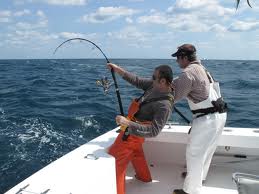
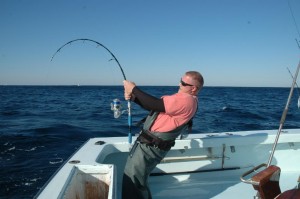
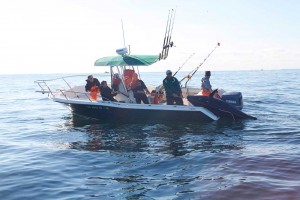




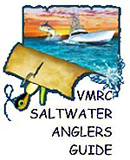




 Views Last 7 days : 1638
Views Last 7 days : 1638 Views Last 30 days : 5866
Views Last 30 days : 5866